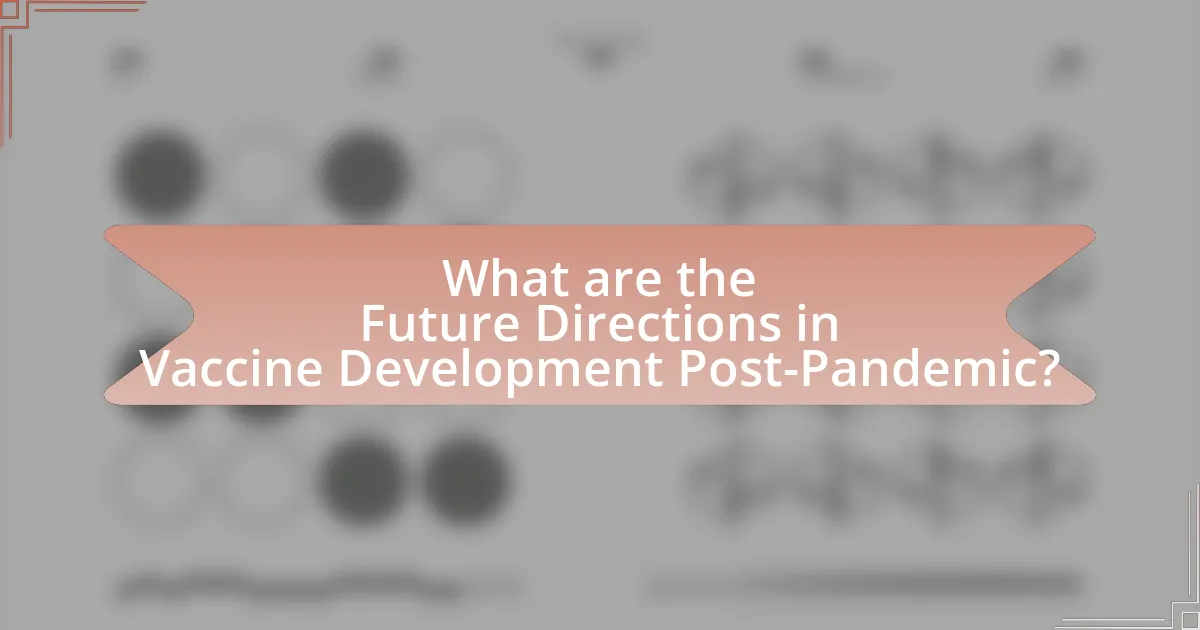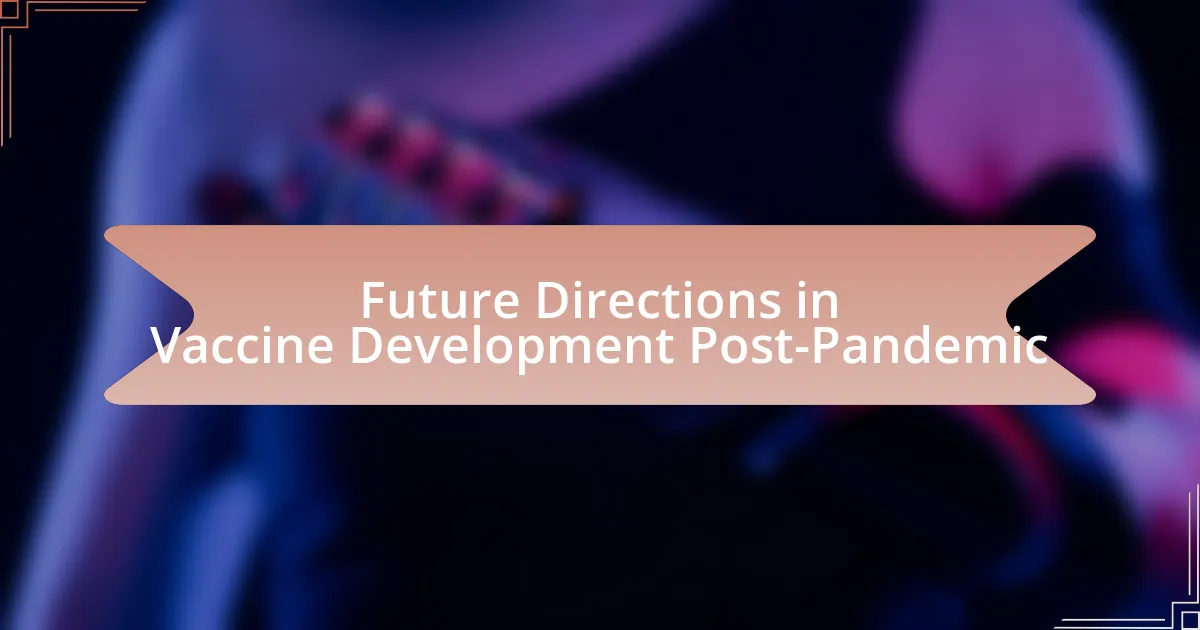The article focuses on the future directions in vaccine development following the COVID-19 pandemic, highlighting advancements in mRNA technology, the pursuit of universal vaccines, and the integration of artificial intelligence in vaccine design. It discusses how the pandemic has accelerated vaccine research through unprecedented collaboration and financial investment, leading to rapid development and regulatory changes. Key emerging technologies, such as viral vector platforms and nanoparticle-based vaccines, are examined for their potential in addressing future health challenges. The article also addresses anticipated challenges, including vaccine hesitancy and equitable access, while emphasizing the importance of collaboration and personalized approaches in enhancing vaccine efficacy and safety.

What are the Future Directions in Vaccine Development Post-Pandemic?
Future directions in vaccine development post-pandemic include the advancement of mRNA technology, the exploration of universal vaccines, and the integration of artificial intelligence in vaccine design. The success of mRNA vaccines during the COVID-19 pandemic has prompted researchers to investigate their application for other infectious diseases, such as influenza and HIV, potentially leading to faster and more effective vaccine responses. Additionally, the concept of universal vaccines aims to provide broader protection against various strains of viruses, reducing the need for annual vaccinations. The use of artificial intelligence can streamline the vaccine development process by predicting immune responses and optimizing vaccine formulations, as evidenced by recent studies that demonstrate AI’s capability in identifying potential vaccine candidates more efficiently than traditional methods.
How has the COVID-19 pandemic influenced vaccine research and development?
The COVID-19 pandemic has significantly accelerated vaccine research and development by fostering unprecedented collaboration among scientists, governments, and pharmaceutical companies. This collaboration led to the rapid development of mRNA vaccines, such as those from Pfizer-BioNTech and Moderna, which were created and authorized for emergency use within a year of the virus’s emergence. The urgency of the pandemic prompted substantial financial investments, with governments and organizations committing billions of dollars to support vaccine trials and manufacturing capabilities. For instance, Operation Warp Speed in the United States allocated nearly $10 billion to expedite vaccine development and distribution. Additionally, the pandemic highlighted the importance of global vaccine equity, leading to initiatives like COVAX, which aims to ensure fair access to vaccines worldwide. These factors collectively transformed the landscape of vaccine research, setting a precedent for future rapid responses to emerging infectious diseases.
What lessons have been learned from the rapid vaccine development during the pandemic?
The rapid vaccine development during the pandemic has demonstrated the effectiveness of accelerated research and collaboration among global health organizations, pharmaceutical companies, and governments. This collaboration led to the unprecedented speed of vaccine creation, with the Pfizer-BioNTech and Moderna vaccines being developed and authorized for emergency use within a year, a process that typically takes several years. Additionally, the use of mRNA technology has proven to be a viable platform for rapid vaccine development, showcasing its adaptability and potential for future vaccines against various infectious diseases. The pandemic highlighted the importance of investment in vaccine infrastructure and the need for flexible regulatory frameworks to facilitate swift responses to public health emergencies.
How have regulatory processes changed in response to the pandemic?
Regulatory processes have significantly accelerated in response to the pandemic, primarily through the implementation of emergency use authorizations (EUAs) that allow for faster approval of vaccines and treatments. For instance, the U.S. Food and Drug Administration (FDA) granted EUAs for COVID-19 vaccines within months of their development, a process that typically takes years. This shift was driven by the urgent need for rapid vaccine deployment to combat the public health crisis, leading to streamlined clinical trial protocols and increased collaboration between regulatory agencies and pharmaceutical companies. Additionally, regulatory bodies worldwide adopted more flexible guidelines, enabling the use of real-world evidence to support vaccine efficacy and safety assessments, thereby expediting the overall approval process.
What emerging technologies are shaping the future of vaccine development?
Emerging technologies shaping the future of vaccine development include mRNA technology, viral vector platforms, and nanoparticle-based vaccines. mRNA technology, exemplified by the Pfizer-BioNTech and Moderna COVID-19 vaccines, allows for rapid design and production, enabling swift responses to emerging pathogens. Viral vector platforms, such as those used in the Johnson & Johnson vaccine, facilitate the delivery of genetic material to elicit immune responses. Nanoparticle-based vaccines enhance stability and immune recognition, as seen in research by the National Institutes of Health, which demonstrates their potential in targeting specific pathogens effectively. These technologies collectively represent a paradigm shift in vaccine development, enabling faster, more adaptable responses to infectious diseases.
How do mRNA vaccines differ from traditional vaccine platforms?
mRNA vaccines differ from traditional vaccine platforms primarily in their mechanism of action. Traditional vaccines often use weakened or inactivated pathogens to stimulate an immune response, while mRNA vaccines utilize synthetic messenger RNA to instruct cells to produce a harmless piece of the target virus, prompting an immune response without using the live virus itself. This innovative approach allows for faster development and production, as seen with the rapid creation of mRNA vaccines for COVID-19, which were developed in less than a year compared to the typical multi-year timeline for traditional vaccines.
What role do viral vector vaccines play in future vaccine strategies?
Viral vector vaccines are poised to play a significant role in future vaccine strategies by providing a platform for rapid development and adaptability against emerging infectious diseases. These vaccines utilize modified viruses to deliver genetic material from pathogens, prompting an immune response without causing disease. For instance, the successful deployment of viral vector vaccines during the COVID-19 pandemic, such as the Johnson & Johnson vaccine, demonstrated their efficacy and speed in response to urgent health crises. This technology allows for quick modifications to target new variants or pathogens, making it a valuable tool in pandemic preparedness and response.
What are the anticipated challenges in vaccine development moving forward?
Anticipated challenges in vaccine development moving forward include addressing vaccine hesitancy, ensuring equitable access, and adapting to emerging variants. Vaccine hesitancy remains a significant barrier, as studies indicate that misinformation and distrust can lead to lower vaccination rates, impacting herd immunity. Ensuring equitable access is crucial, as disparities in healthcare infrastructure can hinder distribution, particularly in low- and middle-income countries. Additionally, the rapid mutation of pathogens necessitates ongoing research and development to create vaccines that remain effective against new variants, as evidenced by the need for updated COVID-19 vaccines to combat variants like Delta and Omicron.
How will vaccine hesitancy impact future vaccination campaigns?
Vaccine hesitancy will significantly hinder future vaccination campaigns by reducing overall immunization rates and increasing the risk of disease outbreaks. Research indicates that vaccine hesitancy can lead to lower vaccination coverage, which is critical for achieving herd immunity. For instance, a study published in the journal “Vaccine” found that areas with high levels of vaccine hesitancy experienced outbreaks of vaccine-preventable diseases, such as measles, which can be traced back to decreased vaccination rates. Consequently, public health officials may need to invest more resources in education and outreach to address concerns and misinformation surrounding vaccines, thereby complicating the logistics and effectiveness of future vaccination efforts.
What logistical challenges must be addressed for global vaccine distribution?
Global vaccine distribution faces several logistical challenges that must be addressed, including cold chain management, transportation infrastructure, and equitable access. Cold chain management is critical because many vaccines require specific temperature controls to maintain efficacy; for instance, mRNA vaccines need to be stored at ultra-low temperatures. Transportation infrastructure is often inadequate in remote or underserved areas, complicating timely delivery. Additionally, equitable access is a significant challenge, as disparities in healthcare systems can lead to unequal distribution, impacting vaccination rates globally. Addressing these challenges is essential for effective vaccine rollout and public health outcomes.
How can collaboration enhance vaccine development in the post-pandemic era?
Collaboration can enhance vaccine development in the post-pandemic era by facilitating resource sharing, accelerating research timelines, and fostering innovation through diverse expertise. For instance, partnerships between pharmaceutical companies, academic institutions, and government agencies can streamline clinical trials and regulatory processes, as evidenced by the rapid development of COVID-19 vaccines, which involved unprecedented collaboration among various stakeholders. This collective effort not only reduces costs but also enhances the ability to respond to emerging infectious diseases more effectively, as demonstrated by the Global Vaccine Alliance (GAVI) and the Coalition for Epidemic Preparedness Innovations (CEPI), which have successfully mobilized resources and expertise to address global health challenges.
What partnerships are essential for advancing vaccine research?
Collaborations between pharmaceutical companies, academic institutions, and government agencies are essential for advancing vaccine research. These partnerships facilitate resource sharing, expertise exchange, and funding opportunities, which are critical for accelerating vaccine development. For instance, the collaboration between Pfizer and BioNTech in developing the COVID-19 vaccine exemplifies how joint efforts can lead to rapid innovation and deployment. Additionally, partnerships with organizations like the Coalition for Epidemic Preparedness Innovations (CEPI) enhance global vaccine research efforts by providing financial support and strategic guidance, thereby ensuring a more coordinated response to emerging infectious diseases.
How can public-private collaborations improve vaccine accessibility?
Public-private collaborations can significantly improve vaccine accessibility by leveraging the strengths of both sectors to enhance distribution, funding, and research capabilities. For instance, partnerships between government agencies and pharmaceutical companies can streamline regulatory processes, allowing vaccines to reach populations more quickly. A notable example is the Operation Warp Speed initiative in the United States, which combined public funding with private sector innovation to accelerate COVID-19 vaccine development and distribution, resulting in the availability of multiple vaccines within a year. This collaboration not only increased production capacity but also facilitated equitable distribution strategies, ensuring that underserved communities received timely access to vaccines.
What are the implications of personalized vaccines for future health strategies?
Personalized vaccines have significant implications for future health strategies by enabling tailored immunization approaches that enhance efficacy and safety. These vaccines can be designed based on individual genetic profiles, which allows for a more precise targeting of pathogens and a reduction in adverse reactions. For instance, research has shown that personalized cancer vaccines can stimulate a stronger immune response by focusing on specific tumor antigens, leading to improved patient outcomes. Furthermore, the integration of personalized vaccines into public health initiatives can optimize resource allocation and improve vaccination coverage by addressing the unique needs of diverse populations. This shift towards personalized medicine in vaccination strategies represents a transformative approach that can lead to more effective disease prevention and management in the future.
How can genetic profiling influence vaccine efficacy?
Genetic profiling can significantly influence vaccine efficacy by identifying individual genetic variations that affect immune responses. These variations can determine how well a person’s immune system recognizes and responds to a vaccine, leading to differences in vaccine effectiveness among populations. For instance, studies have shown that specific genetic markers, such as those related to human leukocyte antigen (HLA) genes, can predict the likelihood of a robust immune response to certain vaccines, including those for influenza and COVID-19. By utilizing genetic profiling, vaccine development can be tailored to enhance efficacy for diverse genetic backgrounds, ultimately improving public health outcomes.
What ethical considerations arise with personalized vaccine approaches?
Personalized vaccine approaches raise several ethical considerations, primarily concerning equity, informed consent, and data privacy. Equity issues arise as these tailored vaccines may only be accessible to certain populations, potentially exacerbating health disparities. Informed consent is critical, as individuals must fully understand the implications of receiving a personalized vaccine, including potential risks and benefits. Data privacy concerns emerge from the need to collect and analyze genetic and health information to create personalized vaccines, raising questions about how this sensitive data is stored, used, and shared. These ethical considerations are essential to address to ensure that personalized vaccine strategies are implemented fairly and responsibly.
What best practices should be adopted for future vaccine development?
Future vaccine development should adopt best practices such as enhancing global collaboration, utilizing advanced technologies, and prioritizing rapid response capabilities. Enhanced global collaboration, as demonstrated during the COVID-19 pandemic, allows for shared resources and knowledge, which can expedite vaccine research and distribution. Utilizing advanced technologies, including mRNA platforms and AI-driven data analysis, can streamline the development process and improve vaccine efficacy. Prioritizing rapid response capabilities ensures that vaccine candidates can be quickly developed and tested in response to emerging infectious diseases, as seen with the swift development of COVID-19 vaccines. These practices are supported by the World Health Organization’s recommendations for strengthening vaccine research and development frameworks globally.
How can continuous monitoring and evaluation improve vaccine safety?
Continuous monitoring and evaluation can significantly improve vaccine safety by identifying adverse effects and ensuring timely responses to safety concerns. This ongoing process allows health authorities to collect real-time data on vaccine performance and side effects, enabling them to detect patterns that may indicate safety issues. For instance, the Vaccine Adverse Event Reporting System (VAERS) in the United States has been instrumental in tracking vaccine-related adverse events, leading to swift investigations and necessary adjustments in vaccine recommendations. By utilizing large-scale data analytics and feedback mechanisms, continuous monitoring enhances the overall safety profile of vaccines, ensuring public trust and adherence to vaccination programs.
What strategies can enhance public trust in vaccines moving forward?
Enhancing public trust in vaccines can be achieved through transparent communication, community engagement, and robust education initiatives. Transparent communication involves sharing clear, accurate information about vaccine development processes, efficacy, and safety, which can alleviate concerns and misinformation. Community engagement strategies, such as involving local leaders and healthcare professionals in outreach efforts, can foster trust by making the information more relatable and credible. Education initiatives that focus on addressing specific concerns and misconceptions about vaccines can empower individuals to make informed decisions. Research indicates that communities with strong educational outreach and engagement efforts report higher vaccination rates and increased public confidence in vaccines.


